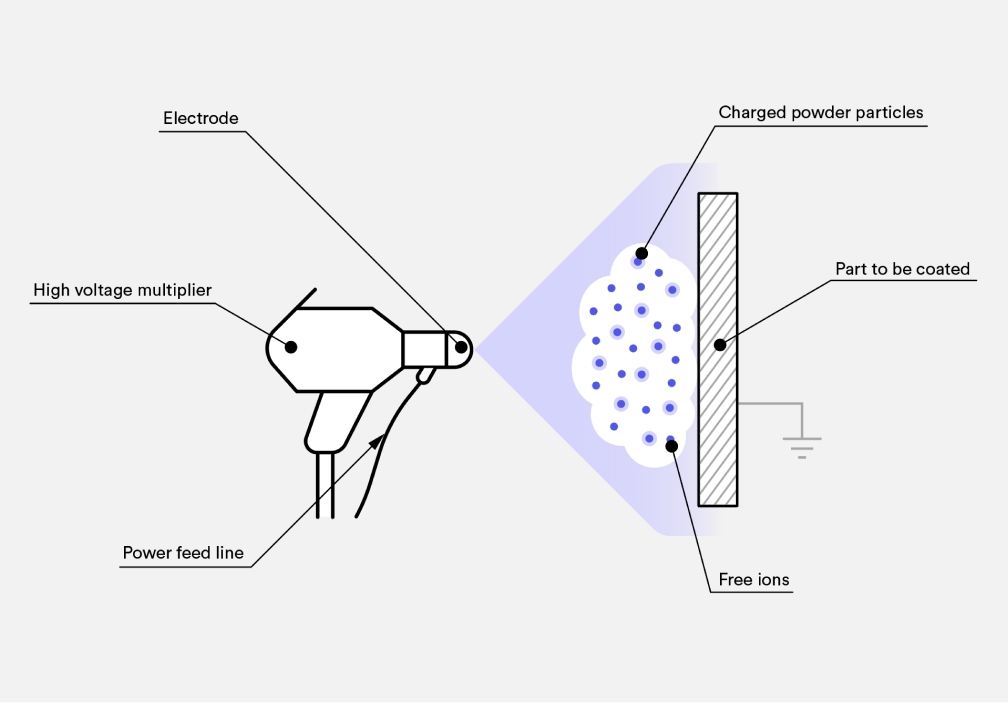Surface Finishes
Powder Coating Services
Powder coating is a dry finishing process commonly used to apply a durable and protective finish to a variety of surfaces, primarily metal.
Powder Coating
Powder coating is a procedure in which a completely dry powder paint (either a polycarbonate or thermoset polymer) is put on a metal surface area making use of electrostatic application. Unlike conventional fluid paint, powder finish does not need a solvent to keep the binder and filler of the paint in liquid suspension. This enables the application of thicker finishings without running or drooping, and the coverings are tougher.
| Applicable Materials | Surface Preparation | Colors | Glossiness | Surface Texture | Cosmetic Availability | Thickness | Visual Appearance |
| Metals | As machined (Ra 1.6μm) | White, Black, and Pantone | Glossy/Matte | Flat/Texture | On request | 50μm to 300μm | Parts are powder coated directly after machining. |
Powder Coating Part


Powder Coating Process
Powder finish is a strong, wear-resistant surface finish that is compatible with all steel products.
Here’s how to apply powder coating:
- Clean parts to remove inorganic contaminants
- To enhance performance and quality, pretreat parts with a conversion coating
- Rinse and dry parts in an oven
- Mask critical areas to prevent tolerance issues
- Coat parts with an electrostatic spray gun
- Dry parts in an oven to cure the coating

Powder Coating Design Considerations
- Hanging and jigging marks: Powder finishing entails putting on hold parts by means of a "jig" or "rack." This will leave marks on your part where powder finishing wasn't feasible. If there are areas where you can not approve "jig" marks, please bear in mind to consist of a technical drawing showing these locations.
- Masking: Remember to indicate in your CAD file whether you want specific part areas to be masked or plugged.As material is applied to the surface during powder coating, all threaded and reamed holes or other critical-to-function surfaces are plugged or masked as standard.
- Tolerances: Tolerances are met before the coating finish. We recommend that you ask for clarifications about masking as needed.
- Conductivity: Powder coating polymers are usually insulative and offer poor electrical conductivity.
FAQs
Powder coating is a dry finishing process that applies a free-flowing, electrostatically charged powder to metal parts, which is then cured to create a durable, protective, and decorative finish.
Powder coating offers excellent corrosion resistance, durability, and a wide range of color and texture options for metal parts.
Standard Colors: These are basic colors like black, white, red, blue, and green.
Custom Colors: Powder coating can be customized to match specific colors according to RAL or Pantone color codes.
Powder coating offers various finishes and textures to cater to different preferences and functional requirements. Some common finishes and textures include:
Smooth Finish: This finish provides a clean and polished appearance, suitable for a wide range of applications.
Textured Finish: Textured powders create surface textures like fine or coarse grains, adding a tactile element and masking imperfections.
Matte Finish: Matte powders provide a non-reflective, low-gloss appearance, often chosen for a subtle and contemporary look.
Satin Finish: Satin powders offer a soft, semi-gloss appearance, combining some reflectivity with a smooth texture.
Gloss Finish: High-gloss powders create a shiny, reflective surface, ideal for achieving a vibrant and glossy appearance.
Metallic Finish: Metallic powders mimic the look of metal and can include various metal-like colors and textures.
Hammered Finish: Hammered or wrinkle finishes feature a textured appearance with a rugged, hammered texture, suitable for decorative or industrial applications.
Vein Finish: Vein or marble finishes resemble natural stone patterns, adding a luxurious and distinctive appearance.
Antique Finish: Antique finishes create an aged or weathered look, ideal for achieving a vintage or rustic appearance.
Transparent Finish: Clear powders protect the underlying material while allowing its natural appearance to show through.
Powder coating is primarily used on metals like steel, aluminum, and iron, but it can also be applied to certain non-metallic substrates.
Yes, powder coating can provide electrical insulation, making it suitable for electrical and electronic applications.
In most cases, post-coating treatment is not necessary, as powder coating provides a complete and durable finish.
Yes, powder coating is not suitable for precision components. The thickness of the powder layer may vary from different manufacturers.The powder layer thickness needs to be considered during the machining process.